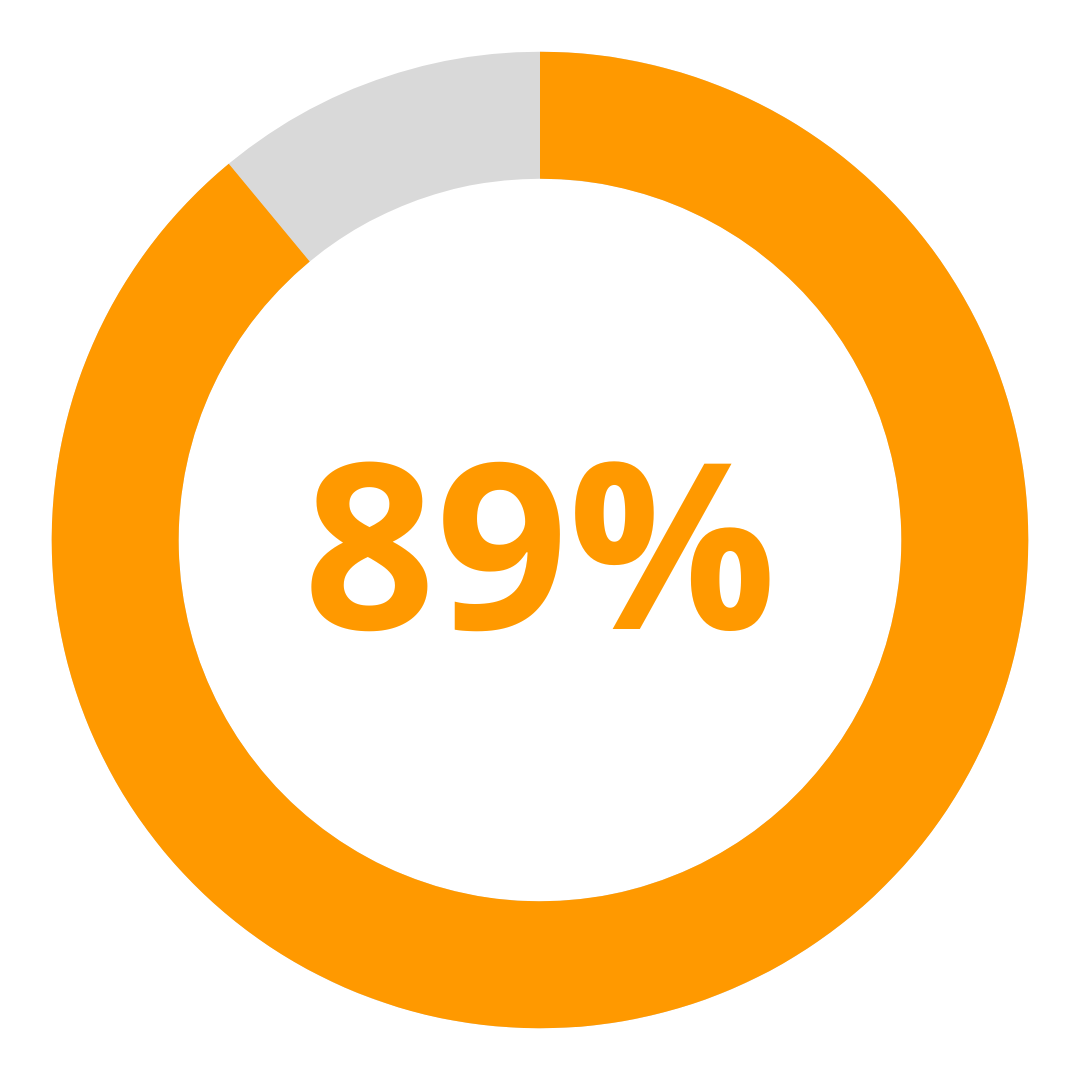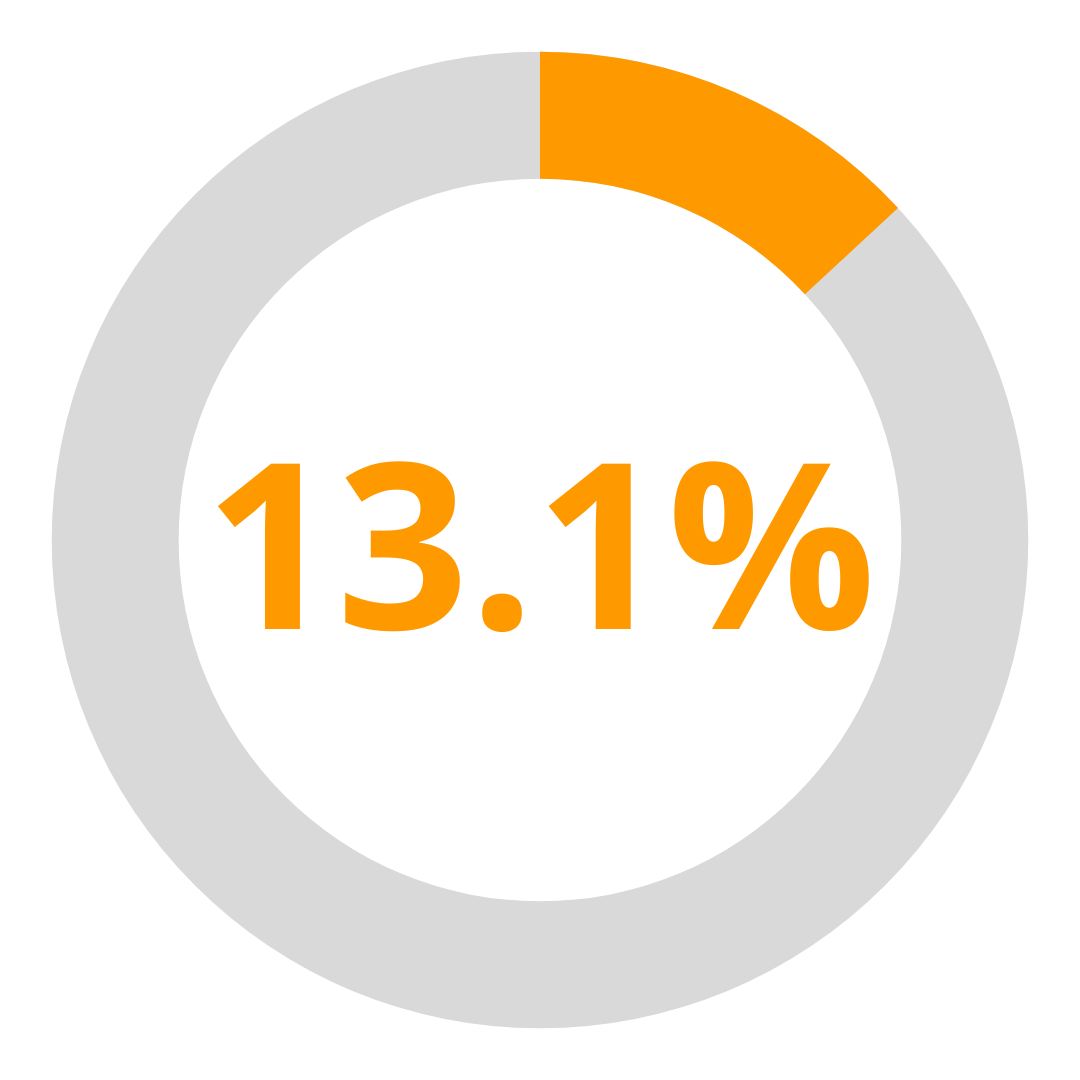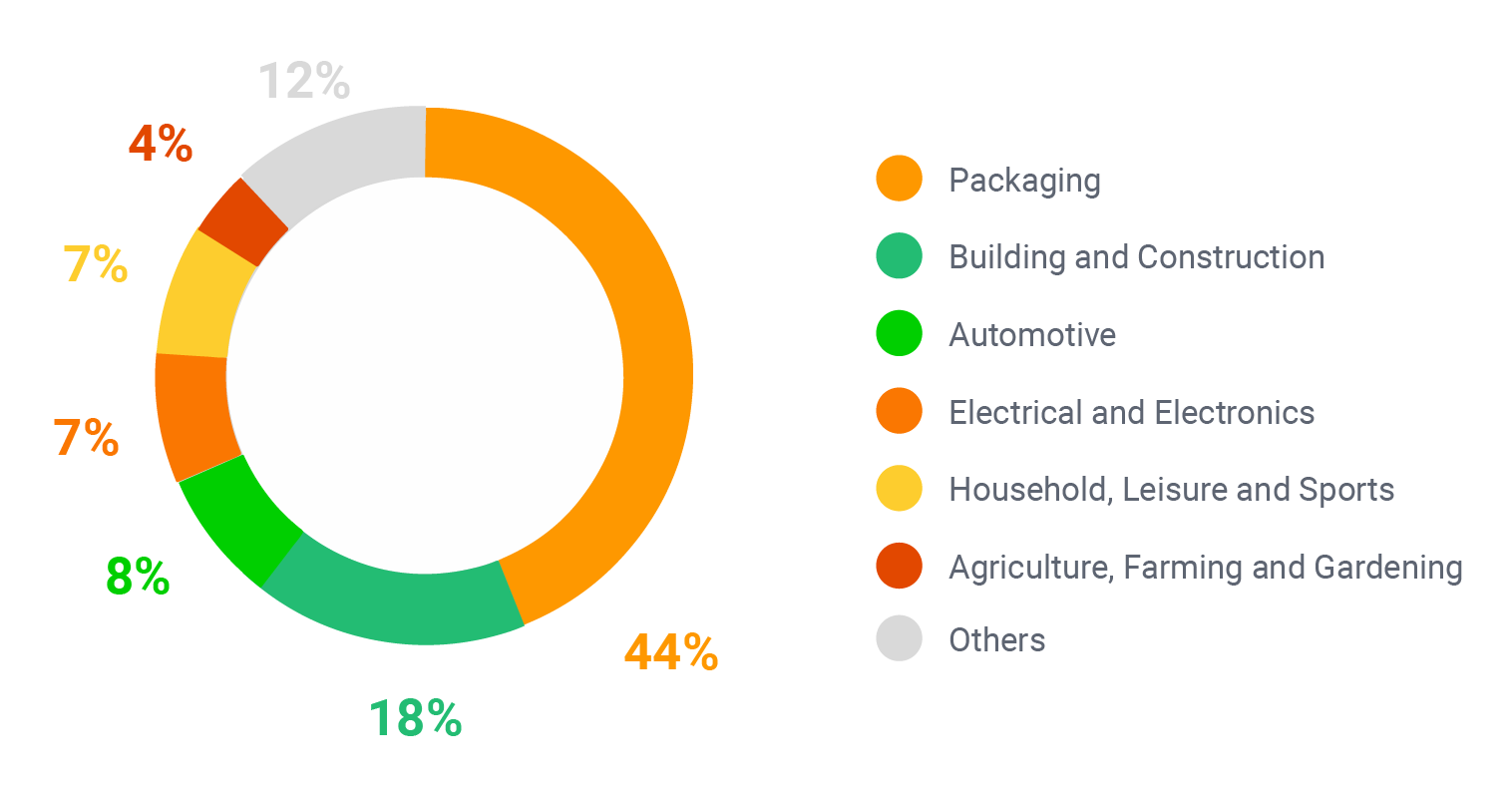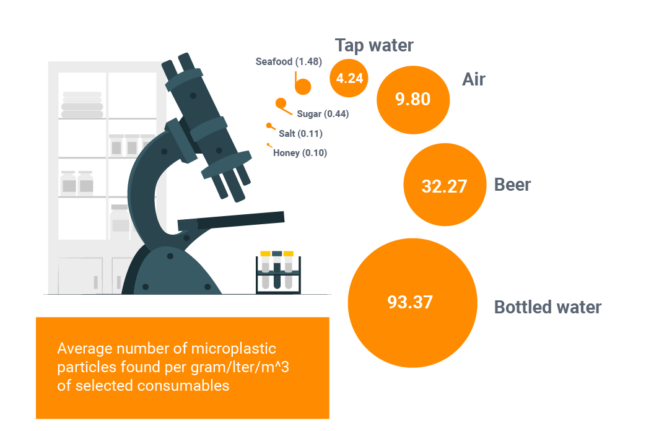Plastic Statistics
2023

Human activities highly impact the environment. More specifically, the widespread plastic pollution issue now plays a predominant role as plastic production is projected to triple by 2060. This Lawn Starter report is an analysis of over 100 governmental and non-governmental reports related to the production, demand, and waste of plastic materials. Additionally, it provides insight into the latest industry information on employment and turnover data in the plastics industry globally.
According to our findings, our dependence on plastic has skyrocketed to unsustainable levels in just over seven decades. Yet as plastics’ global production and consumption continue to soar, we are not disposing of and recycling plastics at the same rate.
Keep reading to find everything you need to know about plastics and what you can expect in the future.
Topics Covered
Plastic Industry

Global Data

Plastics in the Ocean

Consumer's Attitudes Toward Plastic Use

EU Data on Plastics

What the Future Holds

Bottom Line
Topics Covered
Plastic Industry

Global Data

Plastics in the Ocean

Consumer’s Attitudes Toward Plastic Use

EU Data on Plastics

What the Future Holds

Bottom Line
Key Findings
– We produce over 380 Mt of plastic annually, and up to 50% are single-use products.
– The U.S. plastics industry accounts for nearly a million jobs (999,100).
– Ohio had the most plastics industry employees in 2021, followed by Texas, California, and other states.
– In 2021, the plastics industry employed over 1.5 million people in the European Union.
– The U.S. plastic recycling declined to about 5-6% in 2021, down from a high of 9.5% in 2014 and 8.7% in 2018.
– Currently, packaging and building & construction applications are the two largest world plastics markets.
– The latest data show that around 11 Mt of plastic is dumped into our oceans annually.
Plastic Industry
As the sixth largest industry, plastic is essential to the U.S. economy. The U.S. plastic industry accounts for approximately a million jobs and $468.0 billion in shipments. Although employment in this industry fell 0.9% per year between 1997 and 2021, it wasn’t as bad as other manufacturing industries in the U.S., which accounted for a 1.4% decrease per year.
Data regarding plastics manufacturing employment show an increase of 1.8% each year from 2011 to 2021 and 3.2% from 2020 to 2021. This growth exceeded the overall employment growth in manufacturing, which increased only 0.5% annually between 2011 and 2021 and only 1.5% between 2020 and 2021.
Yearly plastic manufacturing employment growth


Yearly manufacturing employment growth


The plastics industry takes part in all 50 states. As seen below, Ohio accounts for most plastics industry employees in 2021, with a total of 75,100 employees, followed by Texas, California, and other states.
Top states for plastics employment (in thousands)


Employment in this industry is projected to decrease by about 0.1%. However, job totals will continue to exceed 2019 levels. Humans generally produce over 380 million tons (Mt) of plastic annually, and up to 50% are single-use products. While plastic products have proven necessary, single-use plastics are taking over and causing significant environmental issues.
Who uses plastic mainly?

Personal household consumption

Private fixed
investment

Government
organizations
Plastic has numerous valuable applications in society, notably in energy, construction, food production, and transportation. Regarding those who purchased products and services containing plastics in 2021, 89.0% went to personal household consumption, 28.9% went to private fixed investment, and 13.1% to state, municipal, and federal government organizations.
How much plastic is recycled?
Although some plastic products have the potential to be recycled, only 3 Mt of plastic were recycled in 2018, equating to an 8.7% recycling rate overall, part of which only 29.1% of PET bottles and jars and 29.3% of HDPE natural bottles were recycled.
Since the early 1990s, the plastics and product industries have encouraged recycling to reduce plastic waste. Yet, to this day, most U.S. plastic waste is still not recyclable. According to estimates, the percentage of recycled plastic in the United States fell from 9.5% in 2014 to 8.7% in 2018, reaching a low of roughly 5-6% in 2021.

Global Data
In 2021, 90.2% of the world’s plastics production was fossil-based. Post-consumer recycled plastics and bio-based/attributed plastics accounted for 8.3% and 1.5% of the world’s plastics production.
World plastics production

Distribution of the global plastics production

Distribution of the global plastics use by application

In 2021, China was responsible for most of the world’s plastics production, with 32% of all production, a 3% increase from 2017, followed by North America at 18%, and other countries.
As expected, packaging makes up for the majority (44%) of plastic usage, taking over building and construction, which comes second on the list with 18%.
Circular plastics represented only 9.8% of the world’s plastics production in 2021.
Distribution of the global plastics production by type
Plastics in the Ocean
More than 11 million tons of plastic is being poured into our oceans yearly. Since oceans are home to many animals, disposable plastic poses a significant threat to them.

Impacts on marine wildlife
Plastics are not biodegradable. Instead, plastics break over time into ever-smaller pieces, known as microplastics which carry severe consequences: the effects on marine life range from individual animal harm to broader effects on biodiversity and ecosystem functioning.
According to one study, 1,288 marine species have been documented ingesting plastic waste. Seabirds, whales, fish, and other marine animals mistake plastic debris for food; as a result, most of them starve to death because their stomachs are so full of plastic. Additionally, they experience internal injuries, lacerations, infections, and decreased swimming skills.
Consumer's Attitude Toward Plastic Use
Created, wrapped, shipped, bought, opened, consumed, and unceremoniously discarded, that’s how humans see the fate of plastics destined. Luckily, the harm posed by plastic pollution to the marine ecosystem is becoming more widely recognized. A poll of over 20,000 individuals from 34 nations reveals overwhelming support for the world’s first plastic treaty to set binding global laws to end plastic pollution.
One of the main rules essential to the treaty is banning single-use plastics. A global average of 75% support the idea of having laws prohibiting unnecessary single-use plastics. Latin America again has the highest level of support (81%), followed by Europe (74%). Regarding countries, Mexico tops the list, followed by Colombia, Peru, Chile, and South Korea.
Support for such an agreement is most potent in Latin America (77%), Europe (72%), and North America (60%). At a country level, Peru and Indonesia reported the highest support levels (81%).
In addition, there are four other measures that consumers globally believe are essential to be incorporated in such a treaty to tackle plastic pollution. In brackets, you can find the percentages of the average global support for each of them.
– Make all the types of plastic that aren’t easily recycled illegal (77%)
– Have producers and retailers be responsible for plastic package reduction, reuse, and recycling (78%)
– Require that all new plastic products be made of recycled plastic (76%)
– Require that all plastic products be (so it’s clear how to sort them for reuse, recycling, or disposal purposes) (77%)
Plastics in the food chain
Unfortunately, plastic has already entered the food chain. Microplastics are less than five millimeters long and can enter the food value chain throughout any stage of food production, including primary production, processing, packaging, distribution, consumption, and even disposal. Researchers found that we consume thousands of these plastic particles annually. And because ingested plastic is inside us, our and future generations’ health may be at stake.
The annual intake of microplastics is believed to range from 39,000 and 52,000 particles. When inhalation is taken into account, these estimates rise to 74,000 and 121,000, respectively. Additionally, compared to people who solely drink tap water, people who consume the recommended amount of water from bottled sources take an extra 90,000 microplastics yearly.
As our graph demonstrates, bottled water is the primary known source of microplastic that enters our systems. Based on four different studies, there are typically 94 particles per liter. Beer comes in second with a score of 32, followed by air, tap water, and seafood.

EU Data on Plastics
Data from the EU shows that by 2020 only 14% of plastic waste was recycled annually. The remaining 86% was either incinerated with energy recovery, landfilled, exported, or littered.
European plastics production reached 57.2 Mt in 2021, of which 5.5 Mt were post-consumer recycled plastics utilized in new goods and parts, an increase of nearly 20% from 2018. This represents a recycled content rate of about 10% in plastics conversion.
As seen below, Netherlands, Norway, Spain, and Germany are the only four countries with recycling rates above 40%. On the other hand, France, Malta, Bulgaria, Hungary, and Finland come last in the list as countries with the least recycled percentages of plastics, none of which reached 30%.
Post-consumer plastics waste treatment per country
Post-consumer plastic waste treatment varies from country to country, but Finland (77%) and Switzerland (72%) lead the way in energy recovery. These countries have established advanced waste management systems that prioritize the conversion of plastic waste into energy through different methods. This not only reduces the amount of plastic waste that ends up in landfills but also generates renewable energy that can be used to power homes and businesses.
Post-consumer plastic waste treatment is a pressing issue in many countries, with Malta (75%), Greece (73%), and Cyprus(71%) topping the list for landfill disposal. Despite efforts to reduce plastic waste and promote recycling, these countries continue to struggle with high volumes of plastic waste ending up in landfills. The overreliance on the landfill as a waste management solution can result in severe environmental and health impacts, including soil and water pollution, greenhouse gas emissions, and threats to wildlife.
In terms of its contribution to industrial value added, the plastics industry in Europe comes in eighth place. An industry with over 52,000 companies gave direct employment to more than 1.5 million people in the European Union and generated around 405 billion euros in revenue in 2021.
What the Future Holds
Plastic waste is projected to almost triple by 2060, from 460 Mt to 1 321 Mt. Although the usage of plastics is expected to rise across all areas, Sub-Saharan Africa and Asia will see the quickest growth. The anticipated increase in plastics consumption in Sub-Saharan Africa from 2019 to 2060 is more than six times higher due to the region’s high economic and demographic growth.
The three areas that account for 60% of all plastics usage, transportation, construction, and packaging, are predicted to see the sharpest growth.
Plastic waste projections
Since plastics are currently used mainly in a non-circular manner, a large amount of plastic waste is produced and released into the environment. The amount of organic waste is expected to double in the following decades, growing from 353 Mt in 2019 to 1,014 Mt in 2060.
From a global viewpoint, Africa and Asia will dominate other countries regarding plastic waste.
How to Stop Plastic Pollution
The harm done by plastic pollution is extensive. It seriously jeopardizes the livelihood of many people, undermines our social cohesion, contributes to climate change, and modifies our natural ecosystems and processes. There is an urgent need for countries worldwide to adopt multilateral action to address this serious impact. As such, countries must:

Bottom Line
The issue of plastics has gained significant attention from the environmental movement recently. Plastic is likely one of the most harmful goods humans have ever created, and its effects will be felt far beyond our lifetimes. As noted above, the leakage of plastics into the ocean harms marine life, causing death to many animals who mistake plastics for food.
Despite its negative impacts, the plastics industry is highly beneficial to the economies by employing millions of people and generating billions of dollars back.